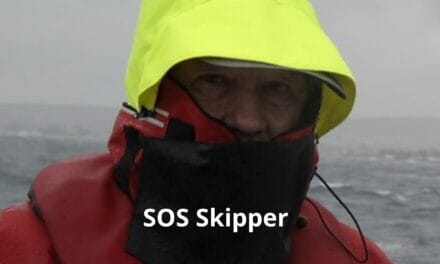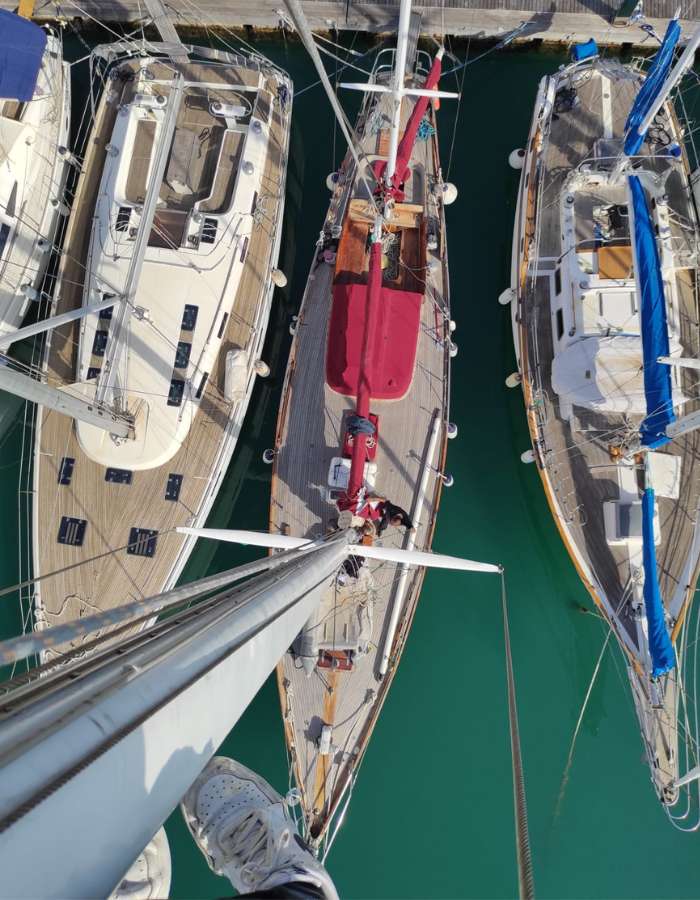Introduction
After some years of sailing blue waters, from the serene lochs of Scotland to the challenging Cape Horn, I’ve learned that a thorough pre-sail check isn’t just a task—it’s a HAVE TO. Whether you’re a weekend sailor or a seasoned yachtsman, this short guide will help you check your vessel is seaworthy before casting off.
Why Meticulous Preparation Matters
Few years ago, during yacht delivery from Canary to UK, I lost batteries and I had to sai 6 days without electricity, using torches as navigation lamps. Fortunately, no traffic until crossing ships route SW of Lisboa. The reason was a refrigerator which was connected straight to batteries (no separation between start and comfort). Had I caught it during my routine check, that small defect had not led to a proper headache. It’s these experiences that remind us: thorough preparation isn’t just about ticking boxes—it’s about safeguarding lives and vessels.
I. Three Pillars of Pre-Sail Checks
- A. Safety First – A comprehensive check isn’t just a routine; it’s a safeguard for you, your crew, and your vessel. According to the Royal National Lifeboat Institution (RNLI), many maritime incidents are preventable with proper preparation.
- B. Prolonging Your Vessel’s Life – Regular inspections catch minor issues before they escalate into costly repairs. A stitch in time saves nine, as they say.
- C. Sailing Confidence: When you know your boat is ready, you can focus on the joy of sailing rather than worrying about what might go wrong.
Quick Tip: Feel comfortable before hiring skipper. Check is yacht delivery safe in our special guide for boat owners
II. Hull and Deck Inspection
Examining the Hull
Start with a walk around your vessel, looking for cracks, blisters, or any signs of damage. Pay special attention to the hull below the waterline for fouling or osmosis.
Deck and Fittings
Ensure all deck hardware—cleats, winches, stanchions—is secure. Check for signs of wear and tear on the deck surface, such as soft spots or delamination.
Joints and Seals
Inspect hatches, ports, and seals for leaks. A simple hose test can reveal if they’re watertight. Trust me; a leaky hatch can turn a pleasant journey into a soggy ordeal.
Top Tip: Pay particular attention to through-hull fittings—they’re often overlooked but crucial for watertight integrity.
III. Rigging and Sails
Standing Rigging
Stays and Shrouds
Examine for corrosion, fraying, or broken strands. Ensure the tension is appropriate; loose rigging can compromise mast support.
Turnbuckles and Terminals
Lubricate moving parts and look for stress signs or cracks.
Running Rigging
Inspect halyards, sheets, and control lines for chafe or UV damage. Replace any lines showing significant wear—better safe than sorry.
Sails Inspection
Spread your sails out to check for tears, mould, or weak stitching. Don’t forget to examine batten pockets and reefing points.
Quick Tip: Keep a spare set of essential lines onboard. It’s better to have them and not need them than the other way around!
IV. Engine and Mechanical Systems
Engine Checks
- Oil Level: Use the dipstick to check oil levels. Low oil can lead to engine failure.
- Coolant Level: Ensure the coolant reservoir is adequately filled.
- Belts and Hoses: Look for cracks or signs of wear. Check tension.
Fuel System
- Fuel Filters: Clean or replace them if necessary.
- Fuel Lines: Check for leaks or deterioration.
- Bacterias: Growing perfect in warm atmosphere (like in MED). When catch first bigger waves after winter stay your oil in the tank will be mixed with bacteria colonies. Next they will flow to your fuel filter and block it. So, inspect fuel tanks!
Propeller and Shaft
Inspect the propeller for damage or debris. Ensure the shaft is properly aligned to avoid vibrations and abnormal leaking.
Bilge Pumps
Test both automatic and manual bilge pumps. A functioning pump is crucial for removing unwanted water.
Engine Maintenance Checklist:
| Item | Checkpoints | Status |
| Oil Level | Dipstick reading | ✅ / ❌ |
| Coolant Level | Reservoir check | ✅ / ❌ |
| Belts and Hoses | Visual inspection | ✅ / ❌ |
| Fuel Filters | Cleanliness | ✅ / ❌ |
| Propeller | Damage/Debris | ✅ / ❌ |
V. Electrical Systems
Battery Condition
- Voltage: Use a multimeter to check battery voltage.
- Connections: Ensure terminals are clean and secure.
- Electrolyte Levels (old battery type): Top up if necessary (for non-sealed batteries). Don’t do that in AGMs 🙂
Navigation Lights and Instruments
Test all lights, including steaming, anchor, and running lights. Verify that instrument readings (compass, depth sounder, GPS) are accurate. You will do that easier at night.
Communication Equipment
- VHF Radio: Perform a radio check.
- Handheld Radios: Ensure they’re charged and operational. Buy some spare batteries. Don’t forget charger
- Emergency Beacons: Test EPIRBs according to the manufacturer’s instructions.
Charging Systems
Inspect solar panels and wind generators for damage. Confirm that charging regulators are functioning.
VI. Safety Equipment
Personal Flotation Devices (PFDs)
Ensure all life jackets are in good condition and readily accessible. Check that you have the appropriate sizes for all crew members. Give them to your crew, instruct how to use them, ask crew to keep their personal jackets and care about them.
Flares and Signalling Devices
Verify expiry dates on flares and replace them if expired. Test your horn and other signalling equipment.
Fire Extinguishers
Check the pressure gauges and ensure extinguishers are mounted in accessible locations. What types of extinguishers you have onboard and when you can use them?
First Aid Kit
Restock any used or expired items. Don’t forget seasickness remedies—better to have them and not need them!
Emergency Position Indicating Radio Beacon (EPIRB)
Test its functionality as per the manufacturer’s instructions.
Comparison of Flare Types
| Type | Visibility Range | Duration | Best Use Case |
| Handheld | Up to 5 miles | 1 minute | Close-range signalling |
| Parachute | Over 25 miles | 40 seconds | Long-range distress alert |
| Smoke Signals | Visible daytime | 15 – 30 minutes | Daytime location marking |
VII. Navigation and Communication
Charts and Navigation Tools
Update your electronic charts and carry current paper backups. Calibrate your compass and verify GPS accuracy. if you have navigation in your phone – download charts to use them offline.
Automatic Identification System (AIS)
Ensure your AIS transponder is both transmitting and receiving correctly. Sometimes it’s in silent mode.
VHF Radio Checks
Perform a radio check with the marina or a nearby vessel to confirm clear communication.
Weather Equipment
Update weather forecasts and check instruments like the barometer.
VIII. Provisioning and Supplies
Water and Food
Verify that freshwater tanks are full and the water is potable. Stock up on non-perishable food items.
Fuel and Lubricants
Top up fuel tanks and carry extra oil and lubricants.
Spare Parts and Tools
Carry essential spare parts:
List 1: Essential Spare Parts to Carry
- Engine oil filters
- Fuel filters
- Impellers
- Light bulbs for navigation lights
- Fuses and circuit breakers
Ensure your tool kit is complete.
IX. Legal Documentation
Vessel Papers
Check that your vessel’s registration and insurance documents are onboard and up to date. Take your skipper and VHF licenses
Crew Documentation
Ensure all crew members have necessary passports and visas.
Regulatory Compliance
Verify compliance with local and international maritime laws. Check for any required permits or licences.
X. Crew Briefing and Training
Roles and Responsibilities
Assign tasks for navigation, lookout, cooking, cleaning and deck work. Clarity prevents chaos.
Emergency Procedures
Conduct a safety briefing covering:
- Man overboard procedures
- Fire response
- Abandon ship protocols
Route Planning
Discuss the planned route and potential hazards. Review weather conditions and forecasts.
Quick Joke: Remember, there’s no such thing as too much communication onboard—unless someone’s trying to sleep off the night watch!
XI. Final Walkthrough
Securing the Vessel
Remove unnecessary mooring lines and fenders. Ensure all lockers and hatches are securely closed.
Stowing Equipment
Secure loose items to prevent them from shifting during sailing. Double-check that all equipment is properly stored.
Last-Minute Checks
Verify that all systems are operational. Start the engine and ensure it runs smoothly and cooling water flows.
Conclusion
Routine
Making this pre-sail checklist a standard practice.
Benefits of Thorough Preparation
A thorough pre-sail check might seem daunting, but it becomes second nature with practice. As my old sailing instructor used to say, “The sea forgives neither carelessness nor ignorance.
Remember, the goal isn’t to delay your departure but to ensure you return safely. Happy sailing, and may you always find fair winds and following seas. Feel free to share your own tips and stories—after all, every sailor has a tale to tell.
Appendices
Appendix A: Sample Pre-Sail Checklist
Download a printable version of the checklist to take onboard:
- Table 2: Pre-Sail Checklist Summary
| Section | Item | Checked (✅/❌) |
| Hull and Deck | Hull integrity | |
| Deck fittings | ||
| Rigging and Sails | Standing rigging | |
| Running rigging | ||
| Sails condition | ||
| Engine and Mechanical | Oil levels | |
| Fuel filters | ||
| Electrical Systems | Battery charge | |
| Navigation lights | ||
| Safety Equipment | Life jackets | |
| Flares | ||
| Navigation and Communication | Charts updated | |
| VHF radio tested |
Appendix B: Recommended Resources
- Books and Manuals
- Chapman Piloting & Seamanship by Charles B. Husick
- The Complete Sailor by David Seidman
- Websites
- Royal Yachting Association (RYA): www.rya.org.uk
- Maritime and Coastguard Agency (MCA): www.gov.uk/government/organisations/maritime-and-coastguard-agency
Appendix C: Comparison of Safety Equipment Brands
- Table 4: Life Jacket Brands Comparison
| Brand | Price Range | Key Features | User Rating |
| Brand A | £50 – £70 | Automatic inflation | 4.5/5 |
| Brand B | £40 – £60 | Manual inflation, harness | 4/5 |
| Brand C | £60 – £80 | Hybrid design | 4.7/5 |
Final Thoughts
Continuous Learning
The sea is ever-changing, and so is sailing technology. Stay updated and keep learning.
Community Engagement
I encourage you to leave comments or share your own experiences. We’re all shipmates in the grand voyage of sailing.
Farewell Note
May you have fair winds and following seas!
Remember: “A smooth sea never made a skilled sailor.” So, prepare well, stay safe, and enjoy the journey!







